Precious metals investors need to understand the coming Silver price surge will not occur due to the typical supply and demand forces. While Mainstream analysts continue to generate silver price forecasts based on supply and demand factors, they fail to include one of the most important key forces. Unfortunately, the top-paid Wall Street analysts haven’t figured out that supply and demand forces don’t impact the silver price all that much.
For example, I continue to read articles by analysts who suggest that industrial demand will impact the silver price in the future. They believe that rising industrial silver demand should push prices higher while lower demand would do the opposite. However, according to my research, I don’t see any real correlation. So, why should industrial demand impact the silver price in the future when it hasn’t in the past?
If we look at the following chart, there doesn’t seem to be a correlation between global industrial silver demand and the silver price:
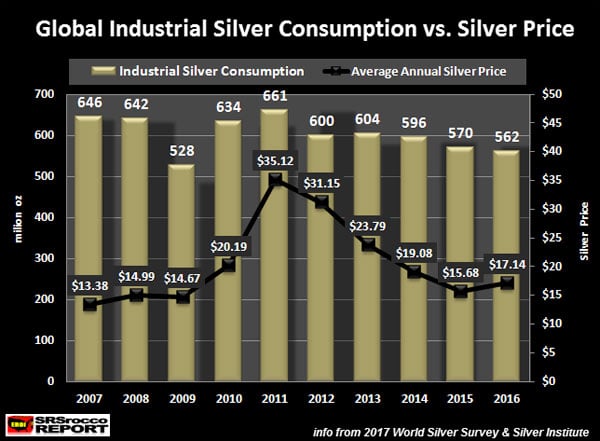
Here we can see that industrial silver demand only increased by 17 million oz (Moz) in 2011 compared to 2008. However, the price more than doubled from $14.99 to $35.12. On the other hand, as the silver price fell in half in 2015 versus 2012, industrial silver demand only declined by 30 Moz (600 Moz down to 570 Moz). Thus, rising or falling industrial silver demand isn’t a factor that determines the silver market price.
Also, many analysts have suggested that a falling silver price would generate more industrial consumption. Unfortunately, as the silver price peaked and declined in 2011, so has industrial demand. Now, some readers may believe that the decline in industrial silver consumption is due to less silver being used in photographic applications. While this is partially true, if we remove photographic silver usage from industrial demand, we can see that industrial consumption of 529 Moz in 2007 was higher than the 517 Moz in 2016:
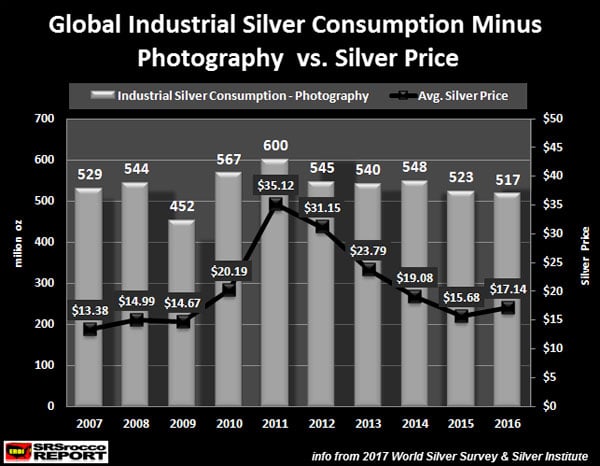
Regardless, forecasts for industrial silver consumption have been consistently wrong. In an article I wrote back in 2014, I stated the following on industrial silver demand:
I have always stated that industrial silver demand, especially solar power demand, will not be much of determining factor in setting the price in the future. Wall Street analysts continue to regurgitate that industrial silver demand will grow for the next 5-10 years. Hogwash.
When the peak of global oil production takes place within the next several years, this will impact Global GDP growth. Matter-a-fact, world economic activity will contract along with the decline in global oil production. This means the demand for silver in industrial applications will decline as well.
Here is a chart showing the forecasted growth of industrial silver consumption from a report by GFMS done in March 2011, for the Silver Institute:
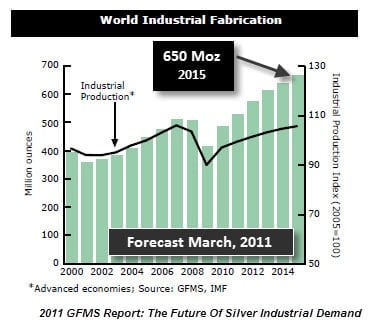
GFMS Analysts projected that industrial silver demand would rise to 650 Moz by 2015. However, If we look at the first chart above, global industrial silver fabrication declined over the past five years falling to a low of 562 Moz in 2016. Even though silver consumption in Solar PV manufacturing may increase for a few years, I believe overall industrial silver consumption will continue to decrease, especially when the markets crack and U.S. and global oil production decline.
Global Silver Scrap Supply Running Low Even At Higher Prices
Global silver scrap supply has hit the lowest level in a decade. According to the data in the 2017 World Silver Survey, global silver scrap supply peaked in 2011 at 260 Moz and fell to a low of 140 Moz last year. That’s a 46% decline in just five short years:
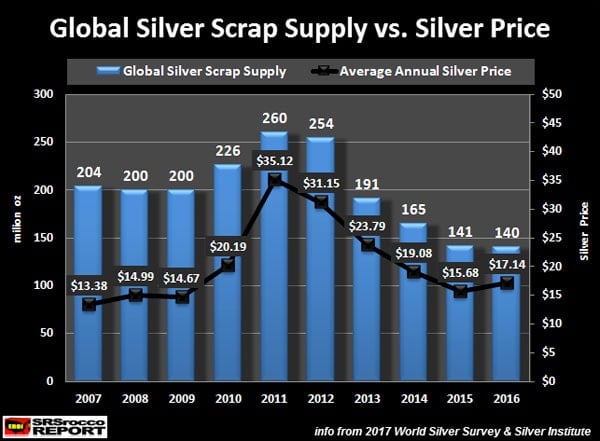
The last time global silver scrap supply was this low was in 1990 when the market only recycled 135 Moz of silver. And get this… the price of silver was $4.82 in 1990. So, with a price nearly four times higher in 2016, silver scrap supply is about the same as it was in 1990. This suggests the market has already recycled a lot of its easy and accessible silver scrap supply.
Understanding the changing dynamics of industrial silver consumption and silver scrap supply is essential for determining long-term valuations of the metal rather than short-term yearly price signals. This means industrial silver consumption and scrap supply haven’t impacted the silver price as much as the price of oil.
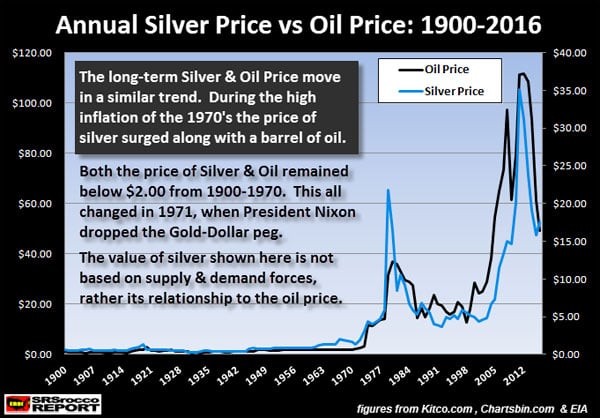
As we can see in the chart above, the price of silver paralleled the spikes in the oil price. Thus, the silver price was based more on the volatile oil price rather than on supply and demand fundamentals in the silver market. However, it is important to know how the individual silver supply and demand sector fundamentals are changing over an extended period.
For example, Net Government silver sales supplemented the market for many years:
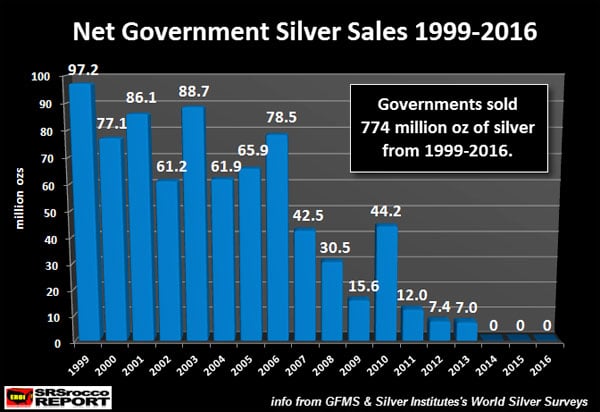
While Central Banks sold a lot of silver into the market, the extra supply didn’t impact the silver price as much as the surging oil price. Although, the important factor to understand about the liquidation of Central Bank silver stocks is that most of this supply has already been sold into the market. According to the data from the 2017 World Silver Survey, Central Banks didn’t sell any silver into the market over the past three years.
Here are three important takeaways from the chart above:
- Central Banks supplemented the market with much-needed silver, but this supply is now mostly depleted
- Central Bank silver sales should not be fundamentally used to determine a short-term silver price, but rather to show how the lack of future government supply will impact the market.
- Central Banks held a great deal of old official silver coins as stocks for decades. The United States had the most, but this was liquidated decades ago. The remaining official stocks were held by a few Central Banks, such as China, Russia, and India. These three governments were the primary source of Central Bank silver sales for the past two decades. However, that supply has been severely depleted and will no longer supplement the market in the future as it did in the past.
Again, I look at Central Bank silver sales as a fundamental that provides information about the long-term dynamics of the overall market, not to be used for short-term price movements.
Putting Silver Market Fundamentals Into Perspective
To understand what will happen to the future silver market and price, we need to analyze the role that the fundamentals play correctly. While most Mainstream analysts focus on supply and demand factors to determine short-term silver prices, I study them to figure out how the entire market is changing over the long term.
As I have stated in many articles in the past, industrial silver consumption is not a fundamental that determines the silver price; rather it reveals to me how the global economy is disintegrating. Furthermore, Central Bank silver sales and scrap supply should not be used to forecast short-term silver price movements. On the other hand, these two fundamentals provide data that suggests silver supply from reliable sources has been seriously depleted.
Unfortunately, some of my readers are frustrated that these fundamentals haven’t pushed silver to much higher prices already. So, when I continue to write articles showing how these silver market fundamentals are changing, they criticize by saying, ”Those fundamentals don’t mean anything or impact the price.” While that may be true currently, it won’t be the case in the future.
Frustrated precious metals investors need to realize the following three important key factors:
- The Silver Market fundamentals are pointing to a perfect storm in the future as reliable past supplies can’t be counted on in the future.
- Most of the physical silver investment is held in tight hands.
- The disintegrating Energy Industry is the most critical factor and the UNKNOWN fundamental that will impact the value of silver in the future.
Of the three key factors above, the third one (the UNKNOWN Disintegrating Energy Industry) will impact the future value of silver the most. However, most of the individuals in the precious metals community are still unaware of how energy will affect the silver price and market in the future. Instead, many in the Alternative Media continue to focus on the silver market regarding the economic and financial industry.
I will be putting out some articles shortly showing just how bad the situation in the U.S. and Global Oil industry has become. When the U.S. and Global Oil Industry starts to disintegrate, it will destroy the value of most Stocks, Bonds, and Real Estate. Thus, precious metals, especially silver…. will experience a price rise never witnessed before in history.

About the Author:
Independent researcher Steve St. Angelo started to invest in precious metals in 2002. In 2008, he began researching areas of the gold and silver market that the majority of the precious metal analyst community has left unexplored. These areas include how energy and the falling EROI – Energy Returned On Invested – stand to impact the mining industry, precious metals, paper assets, and the overall economy.





